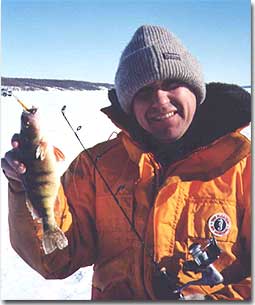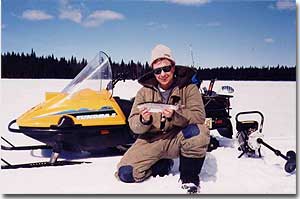Ice Fishing Primer - Get Dressed First
Ice Fishing Primer - Get Dressed First
By Dan Kiazyk
 It’s that time of year again and as per usual, I’m not ready for the ice fishing season. Fall fishing barely ended six weeks ago and deer season has just wound down leaving me with barely anything ready. Without a doubt the phone will ring the next weekend with an invitation to get out on the ice. So what’s doing this year; what did I learn from previous years that might hasten my preparation for the new season? Well, I’ll usually start ground up (with my clothing that is) and focus on lures/rod and reel later on. Having an enjoyable experience comes with good equipment choices (not all need to be expensive either). It’s that time of year again and as per usual, I’m not ready for the ice fishing season. Fall fishing barely ended six weeks ago and deer season has just wound down leaving me with barely anything ready. Without a doubt the phone will ring the next weekend with an invitation to get out on the ice. So what’s doing this year; what did I learn from previous years that might hasten my preparation for the new season? Well, I’ll usually start ground up (with my clothing that is) and focus on lures/rod and reel later on. Having an enjoyable experience comes with good equipment choices (not all need to be expensive either).
Feet: At ice level a pair of cleats on your boots may be necessary. I find that lakes in Manitoba can freeze over leaving lakes like a skating rink – very difficult to get around on to say the least. Next, boots and socks can make or break your day. If you’re drilling holes all day, your boots need to be waterproof. Feet can be kept warmer if a wicking sock (three or four dollars and available at most sports clothing stores – a super investment for anyone that does anything outdoors) is placed next to the foot and a wool sock is worn over it (this is especially important if your feet sweat quite a bit). Boot ratings should be considered. They will give you an idea as to what conditions they can be worn comfortably. If your feet are warm you’ll probably enjoy your day…. That’s what a good friend of mine says quite often….he’s right!
Main body (e.g. legs, torso, arms): Layering is the key when covering up. New space age fabrics can make a difference with wind, snow, sleet etc. e.g. gortex, supplex, etc.. But they aren’t the only warm clothes out there. Don’t forget that items such as wool and fleece can keep you just about as warm as anything else!
Layering allows you to strip down should you work hard drilling a pile of holes or bundle up if cold sitting next to a hole that hasn’t been producing. The secret at this point is to have enough clothes if it should get very cold. Another consideration for layering is that some layers can be one piece, vs. separate pieces. The advantage to single piece components is that there is no point where warmth can escape. The disadvantage to this type of clothing is that it can prove difficult to get out of when it really matters.
Long underwear is a good place to start, with another layer over top eg. sweat pant or other cotton pant. All of this can be covered with a snow pant or a full suit eg. A snowmobile suit. As for the upper torso the order of clothing is much the same as the legs, except that it should be in layers that can be removed and put back on again eg. A sweat-shirt or a vest are two excellent options as they can be removed and put back on very quickly.
Hands/Head: Extremities are really significant for ice fishing. Gloves and mitts are a necessity, depending upon the conditions both maybe necessary. Because fish and live bait live in the water hands will get wet… and cold! Having a second pair of mitts/gloves is almost a necessity if you should dive in a hole after a “beauty” fish. A toque/hat is another necessity as a large percentage of your body’s warmth can be lost through your uncovered head – I remember a “Gerry” –the outdoor clothing company’ advertisement which said, “Feet cold? Cover your head!”
Eyes: Eyes should be covered with a pair of sunglasses that protect you from the sun’s dangerous UVA and UVB rays. Remember the white snow reflects a large amount of sun potentially creating a condition harmful to human eyes.
 The Extras.
The Extras.
Just for those who go off the beaten path a compass and GPS are both good options. Having been caught in a number of white-outs on larger lakes having the prior meant safe exit was a possibility. Hand warmers, heaters are a nice touch, but they do give off noxious emissions and can be bulky. Chemical warmers never really seem able to give off enough heat. You’ll have to decide on their value and practicality. In some instances, I won’t leave home without them but for the most part they stay at home where they won’t be an encumbrance to my run and gun style of ice fishing.
Once I’ve got my clothing in order, I’ll start to focus on equipment. Equipment is the stuff everyone focuses on when heading out on the ice --- much to their detriment. My own approach is to try to not “over tackle” and to keep as light as possible. A pail is a good starting point as it serves many functions: seat, container to carry most equipment and fish (if you’re luckily) minnow bucket –if you have a lid. A rod, reel and tip up and a small tackle box with three types of lures in various sizes and colors (e.g. flash lure, jig, jigging Rapala) are all standard. Stingers are very effective when bites are short and invisible leaders (seven strand wire) are anther significant consideration. Also a good idea (and quite easy to make) is an alligator clip with a larger weight attached. This device serves a number of functions (from depth/ finder, to depth setter on a tip up). An ice serve/scoop helps to break iced over holes or remove slush from a freshly drilled hole. The debate is still out on whether the scoop should be plastic or metal. I’ll usually bring a couple of plastic scoops and at least one metal scoop for more rugged conditions.
As for ice drills, you’ll have to do some homework, if you haven’t already committed some of your hard earned money. A combination of horsepower and blades/auger size dictate how efficient an ice drill will be. I’ve used a jiffy for years now with no problems to report. Other brands are probably as good and are a matter of preference. Some folks want a larger hole while others are comfortable with a smaller hole. A ten inch hole is quite large and most fish can be pulled through it.
Finally, there are some technological advantages that can be brought to ice fishing. A flasher/depth finder can give you an idea of where you’re at and what the fish are doing. For most applications, I find that they’ll slow me down. I do use a hand held Strike Master depth finder unit. I’ll use it to have an idea of depth and that’ all. The nice thing about the unit is that you can put it in your pocket when you are done. Flashers and underwater cameras are quite popular equipment at the moment I’ll even admit to having tried both and all I will say is that they were an educational experience --- especially the underwater camera where I didn’t fish all that much because it was so darned interesting!. The only other problem I find with both flasher and underwater camera is that they’ll slow me down when I’m working a run and gun approach.
Ice fishing can be as simple or as complex as you wish to make it. It’s pretty much the same for no matter what you do. What you’ll put into it, you’ll probably get out of it. As for me, I’ve still got to get my stuff together if I’m going to get out there this weekend!
|
